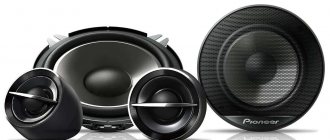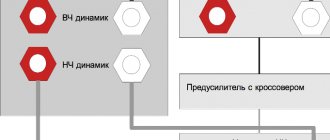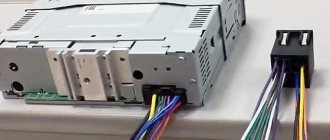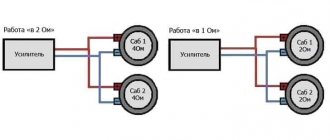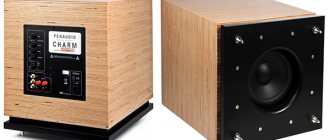Radio output power. Misconceptions and reality.
The author of the article is Alexander Manannikov (alarm), an installer of additional equipment from Tambov
When buying music for your car, many questions arise. One of the most frequently asked questions is how to choose the right speaker for the radio according to power? And I, as an installer with extensive experience, am simply tired of answering this question. Therefore, I took the liberty of writing a short article explaining this topic. I’ll make a reservation right away - this is my first experience, and what I’m writing about has been mentioned more than once and written in many sources.
So, the first question is the power of the radio. From the school physics curriculum we know that power is nothing more than work done per unit of time. By work, in our case, we mean the amount of energy that the amplifier receives in the form of direct current from the car's battery and converts it into electrical energy in the form of alternating current. So what is the difference between the power that is written on the box with the amplifier (radio tape recorder) and the power that is written on the box with the speakers? And the fact that the amplifier transmits power, and the speaker receives it.
Now let's focus on two main questions: how much the amplifier can give out maximum and how much the speaker can receive. The maximum power of the amplifier is determined as the maximum output voltage squared and divided by the load resistance. In other words, if the amplifier output is 6 V and the resistance of most car speakers is 4 Ohms, the result is:
6 square / 4 = 9 W. (1)
You ask a question. Why 6 V? After all, 12 fits the amplifier? Yes, because we have an alternating signal at the output, i.e. amplitude. And we will consider it equal to 6 V. What we got in (1) is called peak power. It should be noted here that the magnitude of alternating voltage can be measured in different ways; accordingly, the calculated output power will depend on the method of this measurement. I will not dwell on this in detail, I will only say that most self-respecting manufacturers use a scale of root mean square values or in English root mean square or RMS. We will use this abbreviation in what follows. What is the point: for a sinusoid, the RMS voltage value is 1.41 times less than the amplitude voltage.
(6 / 1.41) square / 4 = 4.5 W (2)
Thus, we found that the amplifier of most car radios, when powered by 12V, cannot produce more than 4.5 W RMS. Which is not entirely true. Since there is a bridge connection, and with it, two amplifiers work for one load, connected in such a way that the swing of the sine wave at the output doubles. Here the output power will be four times greater than 4.5 W, because the voltage is squared, therefore 18.
(12 / 1.41) square / 4 = 18 W (3)
This is the maximum RMS power that can be squeezed out of the amplifier when powered by 12V.
Where does 4x50 W come from? The fact is that in modern radio tape recorders, the amplifiers have a special circuit that can provide the output stages with an increased supply voltage for a short time. This circuit is only capable of raising the power to 50 watts for a split second. This is what gives the manufacturer the moral right to indicate these same 50 W on the boxes. But if you carefully look at the passport for your radio, somewhere at the end of the passport in small print you can read that the power of your radio is 18-20 W RMS at a THD of 10%. What it is. THD is the coefficient of nonlinear distortion or in English THD (Total Harmonic Distortion). I will not consider this parameter within the framework of this article, if anyone is interested, you can read it in the magazine “Avtozvuk” No. 1-2 for 2005, I will only say that the most comfortable listening is with a SOI of no more than 0.5%. By the way, most car radio manufacturers indicate the RMS output power at a THD of 10%, and it is impossible to listen to music at such a THD without harm to your health.
Amplifier
When choosing equipment, you should pay attention to the fact that the rated power of the amplifier is 1.6 times higher than the power of the speakers. This will be the most acceptable option, since the value of this coefficient indicates that the operation of the amplifier and speakers produces high-quality sound at 60 and 90% of the rated power, respectively. When the indicator is below these values, the “Clipping” effect occurs. This is a form of audio distortion that limits the amplitude of the audio signal. This may render the speakers unusable.
The sound strength of the equipment can be nominal, maximum and peak. The speaker system will produce sound without any noticeable distortion when set to rated power. At maximum, some errors in operation will be noticeable. If you set the equipment to peak sound intensity, this can lead to loss of performance.
Brand.
It is logical to assume that if you do not know how to choose speakers for your car radio and do it as correctly as possible, you should give preference to companies that have been producing speakers for many years and have managed to establish themselves as a guarantor of a quality product. These manufacturers include Alpine, Pioneer, Prology, JVC and others. Often, speakers and car radios from the same manufacturer harmonize very well. Therefore, when buying, for example, a car radio from Pioneer, it makes sense to pay attention to their branded speakers.
Subwoofer
An important element of high-quality sound is also the correct match between the power level of the speakers and the bass level of the subwoofer. Since the sound power of the subwoofer will be much greater than the audio system, and it will not “pull” it, the resulting sound will be of poor quality and simply terrible.
As a rule, expert recommendations indicate that in order to achieve the most optimal sound from a subwoofer, it is necessary that bass amplifiers exceed those of full-range speakers by 2-4 times.
Speakers
There is an opinion that with more speaker power the sound will be louder. No and no again. Many fall for this bait. In fact, it is necessary that the power of the speakers be no less than the power of the car radio itself. By type, sound speakers are divided into:
- coaxial (in common parlance, two or three-way speakers);
- component.
The latter are distinguished by the fact that high frequencies are separated from mid and low frequencies. In addition, their cost is much higher than coaxial ones. The resistance of the speakers should not be low (2-3 Ohms), otherwise irreparable damage will be caused to the car radio, since such a load is extremely undesirable for the amplifier.
If you want to have loud sound, then this, of course, depends on the power of the speakers. Giving preference to sound quality, you need to choose sensitive acoustic speakers, but with less power. In this case, you get high-quality sound that is acceptable in strength, but with less loss in equipment cost.
It must be emphasized that the sound strength of the speakers, which is stated by the manufacturer, does not correspond to the actual sound that the acoustic speakers actually produce. Moreover, if such a difference is small for products of famous brands, then for Chinese-made goods such a gap can be significant. Therefore, you should not buy cheap speakers, since operating them at the limit of their capabilities will lead to damage to the acoustic equipment.
And, of course, when choosing a speaker system, you need to take into account the technical characteristics of your car’s electrical on-board network, as well as its design features. Today, manufacturers offer the market both round and oval speakers of various designs and sizes.
For owners of foreign brands, when choosing speakers, it is recommended to adhere to the standards set by the manufacturer.
So, the time has come to replace the speakers in the car. How to do this, and what do you need to know for this? You definitely need to understand the number of speakers you are replacing, their size, the power that the tape recorder or amplifier will provide (when installed), and the desired power rating of the speakers. It would also be good to understand where to connect which ones.
How to connect?
Popular brands
To immediately predict the characteristics of the sound image inside a car, without having special knowledge, you can buy acoustics from one or another manufacturer. Each brand is distinguished by clearly distinguishable features of the sound and design of its speakers or individual loudspeakers.
KENWOOD
KENWOOD products offer a full range of acoustic systems. You can buy coaxial broadband speakers or a component kit. But the proposals for speakers for regular seats are especially interesting. Such kits allow you to equip your salon with high-quality acoustics with minimal effort.
KENWOOD sound is a balanced sound image without emphasizing the bass. They are well perceived and distinguishable, but situations where the music turns into a continuous low hum are impossible with any adjustments and settings. When working with brand radios, KENWOOD acoustics provide very clear, high-quality sound.
Pioneer
The Pioneer consortium has been working in the car acoustics market for a long time. Prices for speakers and loudspeakers are not affordable. However, this is easily explained by the fact that the company uses its most advanced engineering solutions even in the cheapest systems of its production.
Pioneer acoustics are of interest to motorists because in the range of items you can find a ready-made set of speakers for installation in standard places of a car of a particular model. The sound of the speakers has a low level of distortion. The speaker diffusers and coils show fast response and withstand overloads well. Most models work well in the low frequency region.
Edge
This company is the standard for speaker protection measures. Here you can find thoughtful ventilation schemes, special design solutions for coils and much more. The speakers sound very clear and rich, regardless of type.
The company's offerings include standalone speakers, coaxial systems, and active and passive subwoofers. The features of the products include a clear correspondence of the actual parameters to the declared values. Therefore, to guarantee long-term stable operation of the acoustics, you need to choose the right speakers and Edge speakers.
Sony
The acoustics of this brand are recommended for those who want to get the optimal ratio of cost and quality. The speakers are distinguished by their thoughtful design and the use of classic engineering solutions. Coaxial acoustics are designed for operation in small volumes.
Sony products offer high-quality sound without frills or shifts of the sound image down or up in the frequency band. Each model fully meets the buyer's expectations. Not the least advantage of the brand’s products is their reasonable price and wide range of models on the market.
Hertz
For many, Hertz acoustics are synonymous with quality. The brand's speakers are characterized by a high speed of response to changes in the input signal. Therefore, the acoustics sound rich, powerful, conveying the smallest shades of melody.
Hertz speakers are suitable for playing music of any style. Moreover, even relatively small diffusers cope well with bass reproduction. In the range of the company’s offerings you can find not only acoustics of almost any type, but also everything you need to independently build a high-quality system. You can buy amplifiers, crossovers, subwoofers, and special car electronics with noise filtering.
Coaxial or component
Choosing the right speakers is not that easy. There are currently two types of car speakers in use: coaxial and component. Coaxial speakers include several speakers at once, the so-called strips. There are two-, three- and even four-way speakers. Component speakers are designed to reproduce only a certain segment of frequencies: low, high or medium.
Let’s make a reservation right away that the price tag between coaxial and component speakers varies very, very much; component speakers belong to HI-FI and HI-END equipment and are expensive, and also require a professional amplifier (possibly more than one) and competent installation. Moreover, the location of such speakers in the car is of no small importance for the overall sound quality.
Do you need an amplifier?
We will not go into the features of amplifiers. Let's just consider what it gives and whether it is possible to do without it. An amplifier is primarily needed to increase the output power of the head unit. The inscriptions on the box of the 4x50 W radio tape recorder are true, but only partially; the manufacturer in bright advertising shows the peak power of the device, but in fact there are three powers - nominal, maximum and peak.
Peak power is what the tape recorder is capable of producing at the limit of its capabilities, for a short period of time, with sensitive overheating of the built-in amplifier. We are interested in the rated power - this is something between peak and idle during a song change, the power that the radio delivers most of the time.
The power ratio between the speakers and the amplifier will allow you to choose them correctly for each other. The rated power of the radio is significantly lower than the peak power and an amplifier is required for the full sound of good speakers. But speakers also have their own maximum power, and a powerful amplifier will most likely burn out weak acoustics very quickly. For car acoustics, a 30% power reserve in front of the amplifier is preferable. For example, if the amplifier provides 100 W per channel, then speakers are desirable at 140 W.
We determine the required resistance, sensitivity and other parameters
The electrical characteristics of acoustics play a large role in the formation of high-quality sound and the overall functional suitability of an individual loudspeaker. Each speaker or column is selected according to the following criteria:
- Resistance. It is desirable that this characteristic corresponds to the value specified in the radio data sheet. In this case, the acoustics will operate normally, without causing signal distortion from the amplifier.
- Sensitivity. On the one hand, this parameter describes how quickly the speaker responds to signal changes. On the other hand, it describes sound pressure. When it comes time to choose acoustics, it is worth remembering one feature of the car power network. It contains quite strong interference. Therefore, it would be wrong to choose speakers with high sensitivity. A reasonable solution would be to buy acoustics with a parameter value in the range of 90-95.
- Good quality. This parameter describes how strongly the inertia of the diffuser affects the correct reproduction. For speakers installed in cars, it is advisable to choose speakers with a Qts indicator of at least 0.6.
The last and most important thing is the choice of speaker power. Based on the physics of the operation of the amplifier and the mechanics of signal delivery at different periods of time, it is worth relying on the following postulates.
- The rated power of the acoustics should be at least one and a half to two times higher than the value specified in the passport for the radio. This is the main requirement for car speakers.
- The maximum power should not be less than three times the amplifier rating. This is a desirable, but not mandatory, compliance requirement.
- In some cases, when the speaker manufacturer specifies peak rather than maximum power, it is worth choosing a product that has an exact threefold reserve (or higher).
Some selection principles are worth explaining. The stated speaker power rating is based on testing. The acoustics are supplied with a signal in a wide range of frequencies. The test is carried out according to the scheme one minute of work - two minutes of downtime.
How to install larger speakers
The car has standard seats for speakers. But what if you need to install larger speakers? This problem can be encountered when installing speakers in car doors. For high-quality installation, special podiums are used, which are purchased ready-made or made for a specific car model and speaker size.
Podiums help speakers sound better due to the extra volume they provide and allow you to install the right size speakers. Sometimes podiums are also installed on the rear parcel shelf of a car, but this is done mainly to improve sound quality.
Determining the space for the speakers and their size
In most cases, car manufacturers have already decided everything for the average owner. The design of the case already provides places for installing acoustics. If this is done, it is recommended to take advantage of the auto manufacturer's offers.
In standard places for acoustics, all measures to neutralize vibrations are provided and structural strength is created. The installed speaker will not rattle excessively; it will have enough volume to produce high-quality sound and operate at rated power.
All that remains for the owner of a modern car is to look at the documentation or visually determine which speakers can be installed in the standard compartments. The machine makes it quite easy to get to them, including during wiring.
If the car does not have space for acoustics, it is recommended not to immediately take up a power tool to disassemble the interior and cut holes, but use the experience of other craftsmen. There is enough information on the Internet, on specialized forums, including videos, on how to properly install speakers in a car. When solving this problem, it is necessary not only to obtain good sound and convenient wiring, but also not to compromise the structural strength of the body elements.
Today there are the following standard places for installing speakers:
- in the doors, mid-frequency speakers are located here;
- in the A-pillars of the roof, in the area of the front glass, to accommodate high-frequency satellites;
- in the rear shelf, where high-power speakers with close-to-bass ranges are installed.
Subwoofer placement is considered separately. It may have a design solution that directly indicates its position inside the car body. For example, this could be an acoustic unit for installation in the trunk, on the floor with a flat shape, or as a product for placement under the rear seats.
If one or more elements of the speaker system require their own amplifier for their operation, you need to carefully consider its placement. In this case, it is worth relying on the manufacturer’s recommendations and common sense. The device will need to give off a lot of heat, so it cannot be installed in a confined space.
Number of speakers in the car
Should you put 2 speakers or 4 speakers in your car, or maybe 6? The purity of sound is determined by the quality of the speakers, not their quantity. Many car owners are limited to two mid-frequency component speakers in the front doors and tweeters on the pillars, while a subwoofer is placed in the back, which plays low frequencies. Thus, the entire spectrum of sound in the car is revealed.
Also popular is the option of installing 4 coaxial speakers, 2-3 way in the front doors, 3-4 way in the rear parcel shelf. The number of speakers that can be installed is limited only by the size of the car and the desire of its owner. At various car audio competitions you can see cars with dozens of speakers installed throughout the car. 2 speakers in the front doors may well be enough for you, it all depends on your musical preferences.
Connection
When replacing speakers or installing new ones, pay attention to the quality and condition of the wiring. Thin wires with twisted connections are not capable of transmitting sound efficiently and without loss. There is special wiring for transmitting the audio signal - it is a multi-core copper or silver shielded cable.
For clear and high-quality sound, installation of such wiring is necessary. Pulling new wires to replace the old ones is quite simple; tie a new cable to the end of the old wiring and carefully pull it through the other end of the wire. During the connection process, it is very important not to confuse the polarity; the wide terminal on the speaker is the positive contact.
When connecting speakers through an amplifier, the wiring from the radio is stretched to the location of the amplifier, and from it diverges to the speakers. The amplifier's power wires should not be pulled together with the audio wiring; it is advisable to space them away from each other, this way you can avoid interference from pickup. The amplifier heats up during operation; free space is required for its normal cooling.
It is important not to forget to connect the audio system through a fuse, the power of which is calculated using the formula “Output power / 12 volts = number of amps of the fuse.” For example, 4 speakers are installed, 40 W each /12 = 13.3, we install a 15A fuse.
For some reason I always thought that the power and purity of sound depended on the number of speakers in the car, it turns out. it all depends on the quality. And I didn’t think about the quality of the wiring at all. Now I know.
It turns out that you can find information about everything on the Internet. In short, I went to connect the speakers to the radio, but I thought that for such a “teapot” like me, this mission is impossible) Anything is possible!
I also had to install speakers in my car. Only specialists did the installation, since I don’t understand anything about it. I have many speakers throughout the cabin and the sound quality is excellent. If you wish, you can learn how to install it yourself by reading this article.
Damn, after reading the article I really believed that the sound could be made better. My husband proved it to me, but I didn’t believe it. I bought new speakers on Avito, I was still cursing why, although now I think it’s no big deal, it’s still cheaper than in regular stores. In short, it will change, I have one more review)
